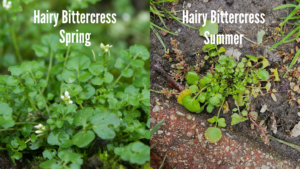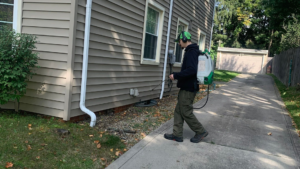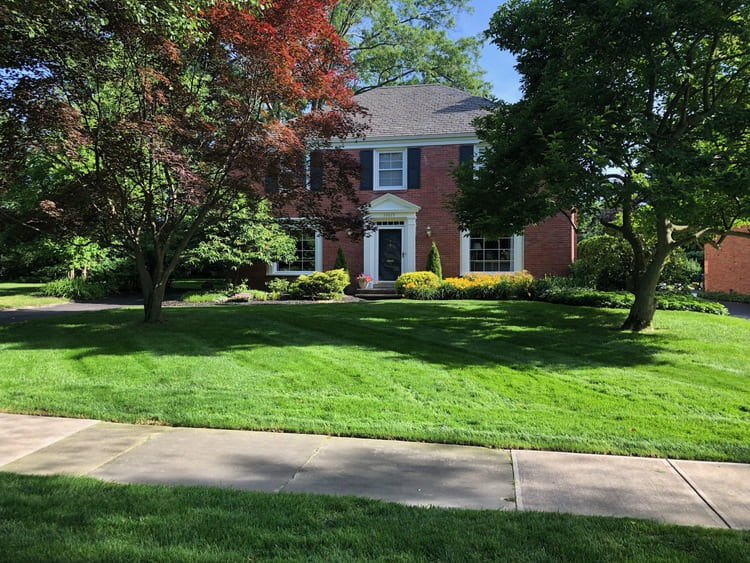Everything You Need to Know About Hairy Bittercress Weed in Ohio Lawns
Imagine stepping outside one day, breathing in the fresh, cool air, and admiring your lush, green lawn. With a cup of coffee in your hand, you’re in heaven—your lawn feels like the perfect picture of suburban bliss.
That is, until you spot it – a tiny weed, with telltale white flowers.
Meet hairy bittercress, Ohio’s sneakiest and most pernicious lawn weed. It looks harmless enough, but don’t be fooled.
A single hairy bittercress plant can produce and disperse up to 1000 seeds, meaning just one plant can rapidly turn into a major (invasive) headache. Seemingly overnight, your lawn can transform from a gorgeous green landscape into a weedy, overgrown mess.
So what do you need to do to take your lawn back from this sly species? Let’s talk about it.
What is Hairy Bittercress Weed?
First, let’s review what exactly hairy bittercress is to help you get the upper hand. After all, you’ve got to know your enemy if you want to fight back against it!
Description of the Plant
Hairy bittercress, scientifically known as Cardamine hirsuta, isn’t just any garden-variety weed.
Native to Europe and Asia, this trespasser decided to make Ohio home sweet home. Picture a small, unassuming plant with delicate white flowers and a knack for stealthy domination. Typically growing to heights of about 3 to 12 inches, its leaves form a basal rosette at the plant’s base.
The leaves are pinnately divided, resembling a feather-like structure. With its bright green hue, hairy bittercress can easily blend into your lawn, with unsurpassed abilities for camouflaging itself.
This cool-season annual weed has a penchant for thriving during the transitional seasons of spring and fall. It loves to make its presence well-known just about everywhere, in gardens, flowerbeds, and even the edges of sidewalks. It particularly appreciates spots where it can take advantage of the weakened turf and is usually one of the first broadleaf weeds to appear in the early spring.
The takeaway? If you’ve noticed clusters of small white flowers popping up in your yard, it might just be the handiwork of hairy bittercress.

Weed Identification
Identifying hairy bittercress is your first step toward reclaiming your lawn. But how do you differentiate it from other cunning weeds lurking in your grass? It looks a little like other weeds, including its cousin, wavy bittercress (Cardamine flexuosa).
To distinguish it from other opportunistic weeds, look for those telltale small white flowers perched atop slender stems. These flowers eventually give way to seed pods that stretch out like tiny green fingers. The pods hold the key to hairy bittercress’s rapid spread – explosive seed dispersal. They’re also one of the best clues at identifying the type of weed you’re dealing with – whether it’s hairy bittercress or something else.
The biggest problem with the plant? Once the pods mature, they can burst open, flinging seeds far and wide like confetti at a party.
Why Is Hairy Bittercress a Problem for Ohio Lawns?
There are two main reasons why hairy bittercress gives Ohio homeowners headaches:
Invasive Nature
Hairy bittercress isn’t just content with being an inconspicuous addition to your lawn. Instead, it’s got bigger plans – like taking over your entire yard. Thanks to the explosive seed pods we mentioned earlier, it spreads quickly, distributing its seeds with the gusto of a toddler with a handful of glitter.
Once those pods pop, seeds scatter in all directions, eager to establish themselves wherever they land. But that’s not all – hairy bittercress has a particular fondness for thin or weakened turf, where it can truly thrive. This means it can quickly overtake areas where the soil quality is already compromised and choke out the plants you actually want to grow there (like your grass).
Impact on Lawns
If you love a lush, vibrant lawn, hairy bittercress isn’t a friend you want to keep around. This weed isn’t just a surface-level annoyance; it competes fiercely with your grass for essential resources like nutrients, sunlight, and water.
Its rapid growth can result in patchy, uneven turf, leaving your lawn looking less like a green oasis and more like an amateur horticulturist’s first attempt.
Not only that, but because hairy bittercress is so invasive, it can spread easily, disrupting the natural balance of your lawn and driving other species out. This lack of biodiversity results in a lawn that’s less healthy and resilient over time.
How Does Hairy Bittercress Grow and Spread?
We’ve hinted at the unique ability of hairy bittercress to spread and multiply rapidly, but how exactly does it do that? Let’s explore.
Seed Dispersal Mechanism
Hairy bittercress doesn’t just lay low and wait. No, this weed has a launching strategy that could rival NASA’s rockets. As we mentioned, its seed pods, called siliques, can burst open at the slightest touch, tossing seeds far and wide. This mechanism allows it to spread rapidly, making controlling the plant even more challenging.
When you or your pets walk through the garden, you’re unknowingly helping the bittercress army. Those seeds latch onto shoes, paws, and clothes, ready to colonize a new patch of earth. Essentially, if your lawn’s a playground, then hairy bittercress is mastering the game of tag.
Growth Cycle in Ohio
Hairy bittercress loves Ohio’s cool weather. It germinates in the fall, lies dormant over the winter, and then bursts into life in early spring. By the time summer rolls around, your lawn could be filled with hairy bittercress.
The best growing conditions for this weed include cool temperatures and moist soils. Unfortunately, your well-watered, shaded areas are prime real estate for this pest. If you’re not careful, that single, tiny green rosette you spotted last fall will turn into a flowering nightmare by spring.
Preventing Hairy Bittercress in Your Lawn
In the battle against Hairy Bittercress, timing is everything. Catch it early, and you’ll have a fighting chance. Waiting too long means you’ll be dealing with a jungle of weeds and a mess of seeds. The first step? Identifying it promptly.
When you spot those tiny white flowers and wiggly stems, it’s time to act. Hand-pulling is effective for small infestations but can be a back-breaking task if your lawn is already a Bittercress buffet.
Prevention, therefore, is the name of the game.
Here are some tips to help you prevent hairy bittercress from taking over in the first place:
Cultural Practices
A healthy, dense lawn is your best defense against weeds of all kinds. Proper mowing, fertilization, and irrigation should be prioritized, as a thick lawn leaves little room for bittercress to sneak in.
Regular mowing keeps your grass high and mighty, shading the ground and reducing weed germination. Fertilize wisely to keep your grass competitive, and water deeply but infrequently to encourage deep roots. A well-fed lawn is a happy lawn, and a happy lawn doesn’t welcome weeds.
Work smarter, not harder. Keep a watchful eye on your lawn, especially in early spring and fall. At the first sign of bittercress, spring into action. Hand-pull any weeds before they can set seed.
If you’re dealing with a bigger infestation, don’t hesitate to bring in reinforcements – your trusty herbicide. Just make sure you’re using a product that’s safe for your grass type and follow the instructions carefully. Timing is key, so again, aim for early spring or fall when Bittercress is most vulnerable.
Mulching and Landscape Management
Mulch isn’t just for aesthetics; it’s your secret weapon against weeds. Apply a layer of mulch in garden beds and around landscape plants to smother bittercress seeds before they can sprout. Mulch also helps retain moisture, reduce erosion, and improve soil health – a win-win for your garden.
Speaking of gardens, bittercress loves to hide among your favorite plants and the grass on your lawn. Regular lawn care and cleanup prevent its seeds from taking root. Remove debris, clear fallen leaves, and keep your garden tidy to deny bittercress a foothold.
How to Control Hairy Bittercress in Ohio Lawns
So you’ve got a hairy bittercress problem, despite your best efforts at preventing it. Now what? Here are some tips to get it gone for good:
Manual Removal
The first line of defense? Good old-fashioned manual removal. This can be time-consuming, backbreaking work, but try to think of it as a workout session for you as you get rid of the weeds.
The best time to roll up your sleeves is before those sneaky seed pods develop, ideally right after it’s rained so the soil is nice and moist (and the roots are loose).
Grab the weeds by the base and pull them out. If you’re using tools, make sure they’re sharp and sturdy to do the job efficiently without just sending seeds and plant pieces flying everywhere.
A dandelion weeder or a similar tool can be your new best friend. These tools allow you to dig deep and remove the entire root system. This prevents regrowth and saves you from doing the same job twice.
Herbicide Control
If manual labor isn’t your thing, herbicide control might be a good alternative. Pre-emergent herbicides are great because they stop the weed even before it gets a chance to pop up. This is especially important for opportunistic weeds like hairy bittercress, which overwhelm a lawn quickly if you don’t get ahead of them.
Timing is key here – apply in late summer and/or early fall to nip it in the bud.
For active infestations, post-emergent herbicides are your go-to. Look for selective herbicides that target broadleaf weeds, sparing your precious grass in the process. Always follow the application instructions to ensure effectiveness and safety.
Organic Control Methods
Want to keep things au naturel? Organic methods are the way to go. Vinegar solutions are surprisingly effective. Simply mix vinegar with a bit of dish soap and spray directly on the weeds. The vinegar’s acetic acid dehydrates the plant, while the soap helps it stick.
Natural herbicides available that focus on eco-friendly solutions are also available. Just remember, consistency is key. Regular applications may be needed to ensure those weeds don’t find their way back.

Long-Term Solutions and Prevention
Want to keep your lawn free of hairy bittercress? It’s all about staying a step ahead. The best offense is a good defense, and that means keeping your lawn healthy and dense.
A thick lawn is less likely to be invaded by weeds because there’s simply no room for them to sneak in. Aerate your soil if it’s compacted, and follow a regular fertilization schedule to give your grass the nutrients it needs to grow strong and lush.
Lawn Care Best Practices
Your lawn deserves to be pampered – and a little bit of pampering can go a long way when it comes to keeping weeds like hairy bittercress at bay.
First, liquid organic aeration. This involves perforating the soil to allow air, water, and nutrients to reach the roots. It’s like giving your lawn a deep tissue massage, encouraging it to grow strong and healthy. Combine this with regular overseeding, and you’ll have a lawn that’s the envy of the neighborhood.
Next up, overseeding. This is the process of adding more grass seed to an existing lawn to fill in bare patches and improve its overall density. The denser your lawn, the less room for hairy bittercress and other weeds to take root. Aim to overseed in the fall for best results.
Finally, stick to a seasonal fertilization schedule. Your grass needs different nutrients at different times of the year, so make sure you’re providing what’s needed when it’s needed. A well-fed lawn is a strong lawn, and a strong lawn is less likely to fall victim to weeds.
Monitoring and Weed Management
Keeping an eye on your lawn is absolutely vital in the battle against hairy bittercress. Regular inspections throughout the year will help you spot any issues early, making it easier to nip them in the bud before they become major problems.
Look for any unusual growth or changes in color. If you see anything suspicious, investigate further.
Prevention is key, but sometimes a little extra help is needed. If you’re struggling to keep hairy bittercress at bay, consider enlisting professional help. Lawn care providers like Ecolawn have access to specialized treatments and expertise that can make all the difference.
The Takeaway
Hairy bittercress might be a formidable foe, but with the right knowledge and tools, you can keep it at bay. Early detection and proactive management are key to maintaining a healthy, weed-free lawn.
Remember, a healthy lawn is your best defense. By following the tips and best practices outlined in this post, you’ll be well on your way to creating a lawn that’s both beautiful and resilient.
If you’re feeling overwhelmed, don’t hesitate to contact the Ecolawn experts. Our professional lawn care services can help you tackle hairy bittercress and other common weeds in Ohio, leaving you free to enjoy your outdoor space without worry.
Join Our Newsletter
FOLLOW US FOR MORE LAWN CARE TIPS


